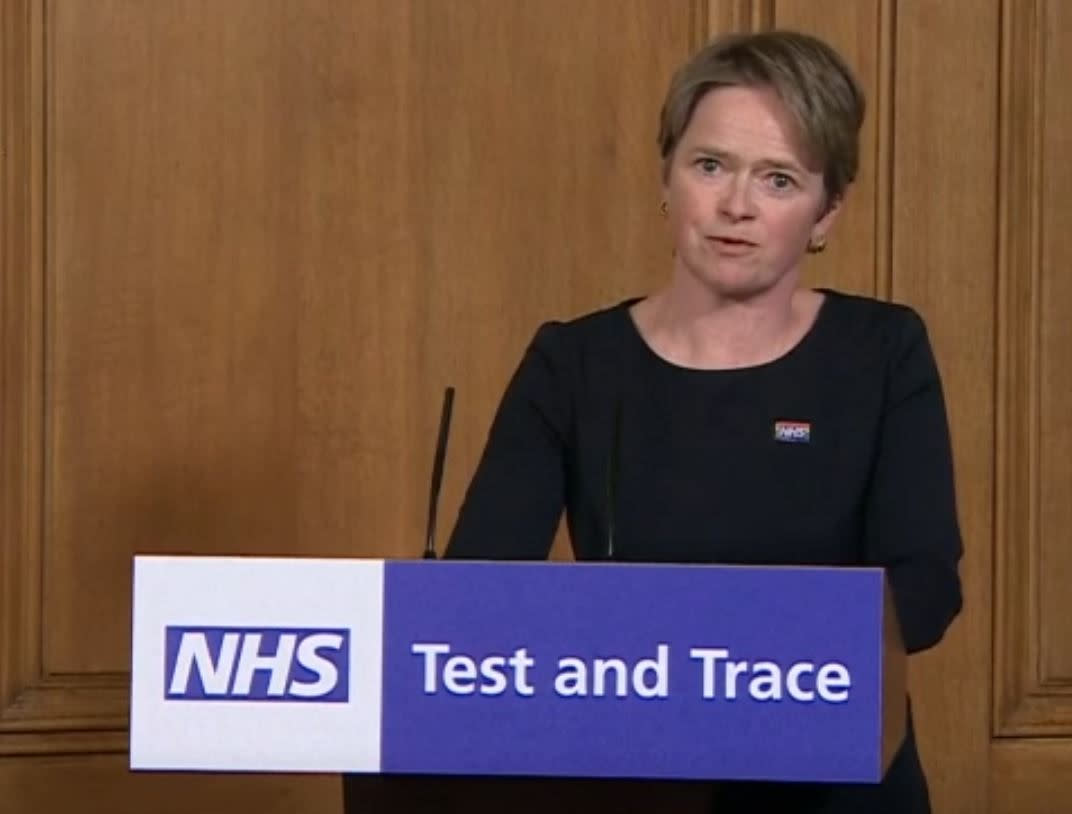'I'm not going to apologise for over-capacity': Baroness Dido Harding defends contact tracers having nothing to do

Baroness Dido Harding has defended the accusation many coronavirus contact tracers have nothing to do.
The NHS’ test, trace and isolate system launched in England on 28 May to help ease the country out of lockdown.
Around 25,000 tracers have been trained to contact people who have been close to a coronavirus patient, asking them to self-isolate entirely at home for 14 days.
Several contact tracers have claimed they have not spoken to anyone since the system launched two weeks ago.
Baroness Harding, who chairs the test and trace service, said it is “a good thing to have excess capacity in advance of lockdown measures being released”.

‘We will over time balance supply and demand’
During an Independent Scientific Advisory Group for Emergencies (Sage) briefing on 9 June, an anonymous contact tracer said: “I’ve had over 50 hours’ paid time working and have not phoned a single person.”
A second unnamed worker added: “I can say I have received four weeks’ pay, but not [had to reach out to] a single contact at all.
“Out of 200 tracers at my agency, we have had four [contacts] to call between us.”
When asked about this during a Science Media Centre briefing on 11 June, Baroness Harding said she knew “we wouldn’t have enough work for all [contact tracers] to do” in the early days of the system being live.
The Baroness thanked the contact tracers, adding: “I’m not going to apologise for [over capacity].
“It’s a good thing to have excess capacity in advance of lockdown measures being released.
“We will over time balance supply and demand.”
She added excess capacity will be needed as the UK heads into winter.
“It’s important to plan for that,” said Baroness Harding.
It has been suggested the coronavirus may become seasonal, with the NHS being under more strain once flu starts circulating.
Not everyone is convinced, however, with the coronavirus peaking in the UK in April and thousands of new cases still arising every day.
What is test and trace?
Anyone in England with coronavirus symptoms – fever, cough, or loss of taste or smell – can request a test.
If positive, they are contacted and asked who they have spent more than 15 minutes with at a distance of less than 2m.
They are also asked who they have had sex with, live with and had face to face conversations with.
Contact details are then requested for the individuals the patient was close to between two days before, and up to seven days after, their symptoms emerged.
These individuals are asked to self-isolate for 14 days, regardless of whether they have symptoms.
Official figures show 31,794 close contacts were identified in the first week of the system being live.
Of these, 26,985 (85%) were reached and asked to self-isolate for 14 days.
These contacts came from 8,117 people who tested positive for the coronavirus, over two-thirds (67%) of whom provided details of who they had been close to.
Independent Sage – formed to provide a “constructive” alternative to the official Sage team – is calling for the system to be revised to “find, test, trace, isolate and support”.
“Find” was added because the group believes many cases are being missed.
“People don’t know they should ask for a test as soon as they can,” Professor Christina Pagel from University College London previously said.
“You’re missing the very first bit of test, trace and isolate, which is find cases.”
Independent Sage is also urging for local healthcare professionals, like GPs, to be involved in the system.
What is the coronavirus?
The coronavirus is one of seven strains of a virus class that are known to infect humans.
Others cause everything from the common cold to severe acute respiratory syndrome (Sars), which killed 774 people during its 2002/3 outbreak.
Since the coronavirus outbreak was identified at the end of 2019, more than 7.4 million cases have been confirmed worldwide, according to Johns Hopkins University.
Of these cases, over 3.4 million are known to have recovered.
Globally, the death toll has exceeded 417,300.
The coronavirus mainly spreads face to face via infected droplets in coughs and sneezes.
There is also evidence it can be transmitted in faeces and survive on surfaces.
Early research suggests the coronavirus is mild in four out of five cases, however, it can trigger a respiratory disease called COVID-19.
The infection has no “set” treatment, with most patients naturally fighting it off.
Those requiring hospitalisation are given “supportive care”, like ventilation, while their immune system gets to work.
Officials urge people ward off infection by washing their hands regularly and maintaining social distancing.
Coronavirus: what happened today
Click here to sign up to the latest news, advice and information with our daily Catch-up newsletter
Read more about COVID-19
How to get a coronavirus test if you have symptoms
How easing of lockdown rules affects you
In pictures: How UK school classrooms could look in new normal
How public transport could look after lockdown
How our public spaces will change in the future
Help and advice
Read the full list of official FAQs here
10 tips from the NHS to help deal with anxiety
What to do if you think you have symptoms



